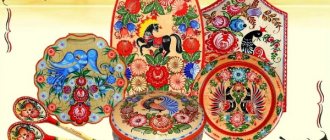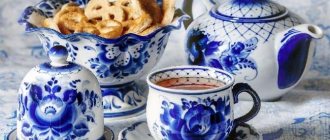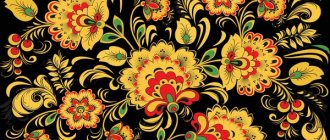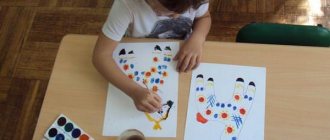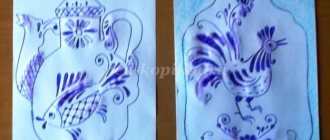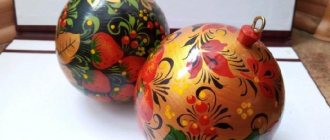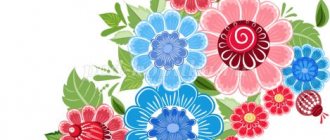- Zhostovo painting - the history of the craft
- Features of magical paintings
- Zhostovo painting in stages
- Zhostovo painting: master class
Still lifes are a very popular artistic genre. Magnificent flowers, ripe fruits, delicious food - these paintings literally emanate happiness, serene pleasure and a thirst for life! However, there are works where familiar themes are presented from a new perspective. Our article will tell you about them, as well as how to make such a thing yourself.
History of the fishery
Zhostovo is a village near Moscow. It was there that the art of painting began to emerge more than 200 years ago. The progenitors of this trend were men from the Vishnyakov family. The father and his sons were engaged in painting decorative papier-mâché dishes.
They owned several workshops located in the settlements closest to Zhostovo:
- Ostashkovo;
- Trinity;
- Khlebnikovo.
Gradually the Vishnyakovs developed their craft and began working with wooden products. Their apprentices painted trays, sugar bowls, and boxes. Cigarette cases, teapots and bread bins were decorated.
By 1825, the Vishnyakov family deeply introduced Zhostovo art into Russian life. Products painted in their workshops became recognizable throughout the country and were in high demand. However, the men did not stop there and tried to expand their fishing more and more. They opened several more workshops in villages further from Zhostovo.
Craftsmen working with the Vishnyakovs began to decorate not only paper and wooden products. They learned to paint on iron trays, pallets and other kitchen utensils. Metal trays turned out especially well. Firstly, the products looked very nice, and secondly, the metal was protected by a layer of paint, and the dishes lasted much longer. New workshops appeared on the territory of Russia until 1920. Masters improved their skills and introduced new elements and motifs into painting.
In 1930, the Vishnyakov fishery encountered difficulties. Soviet departmental organizations wanted to change the Zhostovo painting, adding standard ornaments and compositions that met the requirements of communism. Soviet artists of other directions tried to make the elements of painting more naturalistic and easel.
The masters involved in Zhostovo painting were against these innovations. They understood that in this way art would lose its uniqueness. It will become faded and unremarkable. Devotion to their favorite work and understanding of the uniqueness of this direction helped leading artists defend the right of Zhostovo painting to exist. Art has undergone changes, but very small ones.
After a difficult period, traditional creativity was quickly restored and continued to gain popularity. Masters reached new heights. Their works began to appear at international exhibitions. Soon Zhostovo painting was recognized as a native Russian art.
At that time, it was prestigious to have trays and dishes painted in this style in the house. The Russians tried to buy products in sets so that all kitchen utensils formed a harmonious composition. Dishes were given as gifts for holidays, wedding days and anniversaries.
Closer to the present time, the painting has undergone minor changes . They were associated with the achievements of modern times. Over the past 60 years, the Zhostovo factory, located at the origins of this art, has been producing painted tableware.
Zhostovo painting (pictures with examples of painted utensils can be seen later in the article) despite minor changes in the manufacturing process, factories try to maintain traditions.
Craftsmen create the designs on the dishes by hand. There is no machine application of paint at all. Each painted item is assigned a unique license plate. The shapes of pallets and trays have become varied.
What types of trays are there:
- oval;
- round;
- rectangular;
- square;
- diamond-shaped;
- with high thin sides;
- with thick walls;
- with short sides.
The products themselves are made on machines. Often craftsmen create objects of unique shapes. They order blanks from workshops and blacksmiths. The shape of the product depends on its functionality. Decorative trays have smooth shapes, and those that will be used to carry food and serve the table are easy to wash and use in everyday life in general. The tray can be equipped with handles, as well as loops for hanging dishes on the wall or in a cabinet.
Currently, Zhostovo painting remains popular. The works of specialists are highly valued and continue to be exhibited at international exhibitions, as well as at auctions.
Lesson “Introduction to the Zhostovo craft in the middle group”
Minnulina Almira Rasikhovna
Lesson “Introduction to the Zhostovo craft in the middle group”
Lesson “ Introduction to the Zhostovo craft in the middle group ”
Goal: to introduce the decorative art of Zhostovo crafts ; consider, highlight characteristic elements; Develop artistic taste.
Teaching methods: examination, examination of samples, verbal, practical.
Materials: trays, audio recording of the Russian folk song “There was a birch tree in the field”
, tray stencils, gouache, brushes No. 2,3,5
Features of the painting
Zhostovo painting (pictures with photographs of different dishes will help you better see the traditional ornament) remains a family craft. Parents often begin teaching their children at an early age. Often they practice this art themselves. Young masters spend several years studying and only when they reach adulthood do they become aware of all the secrets of creating a traditional drawing. Subsequently, professionals become mentors for the younger generation.
Painting of Zhostovo trays is done only by hand using squirrel brushes
The main rules for creating a drawing:
- The process must be done manually only. There should be no easel methods of applying paint to the product.
- Large sets of art brushes are used for work. The pile should be squirrel. Other brushes produce less neat and smooth strokes.
- The drawing is created with oil paints. Paints can only be thinned with linseed oil. It gives the paint a soft texture, allowing it to lay on the surface in an even layer, without streaks.
Another main feature is the application of strokes in layers in a certain sequence. First, the craftsman coats the product with black paint. Then he begins to draw floral motifs, combining bright and pastel shades. Thanks to this technique of applying paint, the design turns out beautiful, contrasting and eye-catching.
To decorate dishes, artists use traditional compositions:
- a bunch of wildflowers;
- bouquet of large inflorescences;
- scattered flowers;
- wreaths of small flowers (used to decorate round and oval trays);
- 3 large flowers in the center of the product;
- branch with flowers in the corner;
- flower frame.
At the end of the work, the master assigns license plates to the product and leaves an autograph in the corner of the image. These elements indicate the authenticity of the painting. Beautiful floral arrangements transform plain black trays into works of art.
Required materials and tools
To create a drawing similar to Zhostovo painting, you will need the following materials and tools:
- paints, for such painting it is best to use gouache;
- colored paper or cardboard in black, green or blue; if you don’t have anything suitable at hand, you can take plain paper and tint it with the indicated colors;
- brushes numbered 2, 4, 5, it is recommended to use kolinsky or squirrel brushes, as they help best draw small details of the composition;
- container with clean water;
- a piece of cloth to wipe brushes;
- cotton buds;
- palette.
Colors of Zhostovo painting
Traditionally, the following shades are used to decorate different parts of the picture:
| Background | Black, silver, blue, red, dark green. |
| Flowers | Red, orange, pink, yellow, blue, blue. |
| Leaves | Green, light green, yellow, white, gold. |
| Zoomorphic elements | Brown, orange, yellow, red, white, gray, blue. |
| Frame (sides of tray, edges of dishes) | Golden, silver, yellow, red, black. |
After a difficult period in the development of painting (1930), bright colors began to be diluted with pastel shades. Flowers are often depicted with highlights using white paint. Zoomorphic elements now look more realistic than before. In general, painting has become more diverse.
Recently (from 1970 to today), ivory has become a popular color for background decoration. On a light, slightly beige background, bright flower bouquets look no less elegant than on a dark color. A light background looks softer and gives the dishes a gentle, cozy character.
Zhostovo painting, pictures depicted on dishes and other kitchen utensils, thanks to a wide color spectrum, attract the attention of even those people who are not interested in traditional creativity. This fact has always been a sign that art is truly unique and interesting.
Tray Museum
A wonderful, very informative and modern Museum of Trays operates today at the factory. It is there that the children will listen with the greatest interest to the history of the origin of Zhostovo painting - not just an excursion, but a full-fledged master class will be organized for children.
Every child is interested in finding out “what’s inside?”, and it’s also interesting to visit the factory itself. Such excursions not only educate and develop, they inspire children to creativity and self-knowledge through art initiatives.
Among Russian crafts, no less interesting is the history of the emergence of Khokhloma, which you can get acquainted with in our article: “How Khokhloma arose: history, interesting facts, development of the craft.”
The Zhostovo fishery today is not an enterprise that acts only as a custodian of traditions. This is a modern, developing factory that sells a large line of products, works with children and adults, provides training and allows the beautiful folk craft to live and continue.
Elements and patterns of Zhostovo painting
Pictures consisting of elements of Zhostovo painting looked a little different in the early period. The lines were less smooth. Fewer colors of paint were used to create the design. On painted dishes from 1830-1900. the main elements were landscapes, flower bouquets and a troika of horses.
In the process of development of creativity and the emergence of new artists who had different views on the art of painting, compositions began to change. Landscape landscapes, images of waterfalls, mountain views and castles with beautiful Gothic architecture began to appear in the original works of the new masters.
Subject drawings were often used that depicted the daily life of people of that time. For example, you can find pictures of trays and utensils created in 1890-1900. They depict children riding a sleigh, a sled with horses and a coachman, a tea party with a samovar. Images of people weaving bast shoes were also popular.
Later, images of flower bouquets became the main compositions. Flowers can be different: field, garden, small and large. Large buds or open inflorescences are often depicted in the middle of the picture. Smaller flowers are painted along the edges. Small inflorescences are placed between the main flowers, covering empty spaces.
Rose is the most common flower depicted in Zhostovo paintings. Opened petals look bright and unusual. You can come across an image where roses are drawn in varying degrees of openness of the flower, from a tight bud to a fully open and slightly fading rose.
What other flowers can be seen on dishes decorated in the style of Zhostovo painting:
- red poppies;
- yellow, red and blue tulips;
- yellow and red dahlias;
- pink peonies;
- white small lilies of the valley;
- yellow and lilac pansies;
- small blue cornflowers;
- light blue snowdrops.
The compositions do not look the same because the artists add variety to them by adding bunches of berries, fruits and other fruits to the bouquet. The result is colorful patterns.
From 1920 to the present day, zoomorphic motifs and solid images of birds and domestic animals have been preserved in Zhostovo painting. These designs look very realistic and go well with floral patterns. The most popular type of bird that painters capture is the peacock, or the firebird (phoenix). The artist draws the smallest details, feathers, crests, sticking out hairs. The long tail is often depicted as a flower carpet.
If the specialist has chosen a less realistic direction, then he draws the outline of the bird and fills it with large patterns of arbitrary shape. Most often, the color of such drawings is yellow, and the outlining and darkening of details is done with orange or red paint.
Also popular are images of roosters, larks, crested birds and jays. Wood grouse are often drawn against a dark background. The dark blue color of its feathers almost merges with the black background, but the artists skillfully highlight the contours of the bird with white paint, which creates the effect that the capercaillie is coming from somewhere in the dark. Among the representatives of the animal world, in the drawings you can see horses, deer, bears, and less often cats and tigers.
Sometimes you can find images of fish on decorative dishes. They are never realistic. Typically, the contours are filled with patterns, choosing shades of paint that match the main floral design. Flowers are painted so that they resemble algae. Draw long, curly stems and small inflorescences of dark green, yellow or red.
Today, paint application technologies and the composition of painting materials have been improved, which allows painters to decorate not only wooden and metal utensils. Painting can be done on glass, ceramics and leather.
The paint does not wear off or chip. Therefore, authentic products made by famous craftsmen are expensive. Sets, trays and plates are often purchased as souvenirs for anniversaries, and they are also collected in collections of prized antiques.
Pattern creation technique
Zhostovo painting (pictures are painted on different surfaces using the same technique) is created in 9 stages.
Stage 1 – painting. How it is done:
- The surface of the dishes is degreased.
- Apply primer. This is a special composition that will not allow the paints to roll off and will help fix them so that the design does not rub off.
- After drying, the dishes are painted in the color that will be the background.
- The master selects a sketch. Then he makes marks to consider several options for placing the design on the surface.
- The artist makes the first strokes with a wide brush. He outlines the position of large buds, leaves and petals. Often at this moment the master has several works on his table at once. He designs them at the same time.
- The sketch needs to be fixed. To do this, the dishes are placed in a drying cabinet. The minimum drying time is 12 hours. Additional time, as well as the drying temperature, depends on the material from which the item is made.
The dishes are removed from the cabinet and cooled.
Next, stage 2 begins - straightening. The artist draws the shapes of large elements more clearly. Adds new layers of paint, making the sketch brighter.
The next, third stage, is called “shadowing”. How it is done:
- The artist applies thin layers of paint on top of the sketch. He dilutes them with oil so that the consistency is translucent.
- Dark elements of the design are painted with denser colors.
- They darken the base of the buds, highlight the shadows between the petals, mixing paints on the palette.
- Using a thin brush, mark the position of the veins on the petals and leaves.
- Add texture to the stems.
Stage 4 – laying . The artist uses pastel colors. He highlights the light parts of the plants by applying denser layers of paint.
Stage 5 – glare. How it is done:
- Using a wide brush and white paint, the artist highlights large highlights.
- The strokes are carefully shaded. They should be smooth, without clear contours.
- Using a small brush, highlight light lines on the edges of petals, leaves and stems.
- Light veins are carefully drawn with sweeping brushes. There is no pressure on the brush. Only the tips of the pile, dipped in white paint, touch the design. Smooth, very thin lines should remain.
Stage 6 – drawing. The artist uses a thin brush and white paint. Now he makes clear and bright lines. Outlines all the light areas of the drawing. Highlights the edges of buds, tips of leaves and highlights on berries.
Stage 7 – seeding. Using yellow, orange, light green and white paint, the artist paints the stamens, pistils and seeds. Adds several small dots to the background. They usually imitate small flowers.
Stage 8 – binding. This is the process of “linking” a picture into a single whole. The artist fills in the gaps between the large details of the drawing. These can be dots, small flowers, petals and tiny leaves. Shadows are also applied to all these elements and highlights are highlighted.
Bouquets tied in a bunch or scattered flowers are decorated with thin blades of grass. They are painted in light green, dark green and yellow. Against a light background, grass may appear brown or dark yellow. The painter fills the empty spaces so that the grass forms a light web. Without this step, the drawings would look less realistic. Large gaps between the main elements dull the attractiveness of the picture.
The last, 9th stage is the design of the frame. The frame is drawn by other, specially trained specialists. They mainly use paint of metallic colors: gold, silver, and less often bronze. Patterns are often painted with black or red paint on a light background.
The ornaments that are used to decorate the sides of dishes are silhouettes of leaves and petals. Sometimes these can be small inflorescences, as well as intertwining lines and geometric shapes. Silhouettes of animals are used less often.
The frame can be multi-level, for example: 1 circle consists of lines that form even loops that are identical to each other. The next circle is located under the first. It consists of quatrefoils. The last circle is dots and small flowers.
Zhostovo painting has been around for a long time, and although the art has gone through difficult times, it has changed little, and therefore it can be considered an original Russian craft. The pictures will help connoisseurs of traditional art learn to distinguish genuine factory works from copies.
Author of the article: Frolova Ekaterina
Stages of creating a drawing
Stages of creating a Zhostovo tray:
- Painting. Choose a theme for the composition and create sketches of the bouquet.
- Tenezhka. They cast shadows and give volume to flowers.
- Pad. All elements of the composition are carefully written out.
- Glare. There are highlights on all the details. The effect of illumination of the bouquet is created. Thanks to this, the flowers gain volume.
- Drawing. To perform this step, use a brush. Thanks to this painting, the flowers look like real ones. The master makes veins on the leaves, draws seeds and other plant details.
- Binding. Using stems and leaves, the bouquet is assembled into a single composition.
- Cleaning the edges. This is the final stage of tray design. The sides of the product are decorated with various ornaments.
This is a complex painting technique that is used only by professionals. For beginners, it is best to first master simple pictures made on sheets of paper.
